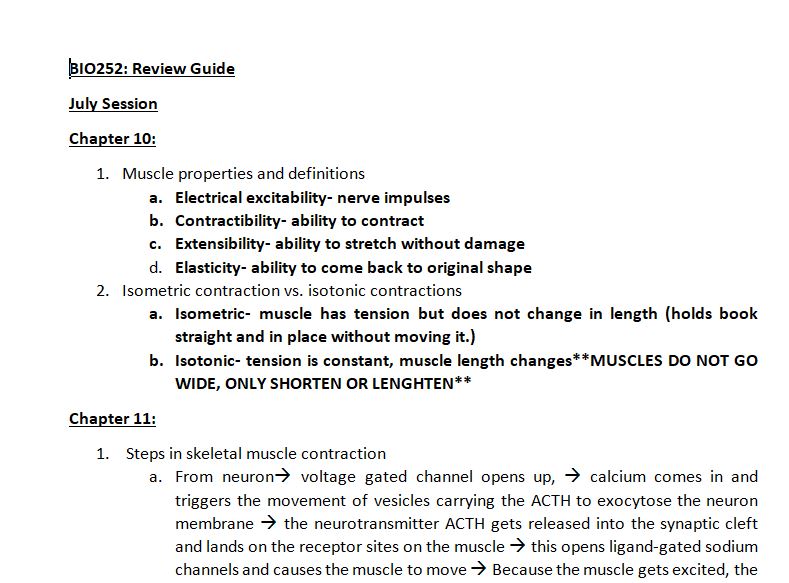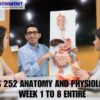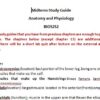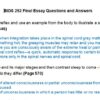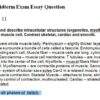Description
BIO 252 Final Exam Unit 8 – Review Guide
Chapter 10
- Muscle properties and definitions
- Isometric contraction vs. isotonic contractions
Chapter 11
- Steps in skeletal muscle contraction
- Definitions:
- Origin
- Insertion
- Antagonist
- Agonist
- Identification of parts of lever system
Chapter 12
- EPSP vs. IPSP (neurotransmitter)
- 11:35 Graded potentials vs. action potentials (location) pg. 424
- 14:25 Neuroglial cells and functions (6 kinds, 4 CNS, 2 PNS)
Chapter 13
- Internal anatomy of spinal cord (which types of neurons go through them)
- Cervical enlargement (Part of body the nerves supply)
- Lumbar enlargement (Part of body the nerves supply)
- Autonomic nervous system (which effector to they control)
- Ascending tracts-
Chapter 14
- Meninges layer
- Cranial nerves (number and function) OOOTTAFVGVAH
- Wernicke’s area (function)- speech comprehension,
- Broca’s area(function)- speech production
- Location of:
- Functions of:
- CNS vs. PNS (components)
- Location of all 4 ventricles
Chapter 15 or 16
- Sensory modalities (how many for a single neuron)
- Sensory Receptors
Chapter 17
- Cochlea (function)- vibration comes in from external ear and it is translated to hearing
- Semicircular canal (function)
- Presbyopia
- Cones/Rods-
- Olfactory receptor (what type of receptor)
- Iris (description)
- Primary taste sensations
- 54:10 Special senses
- Optic Chiasm (function)
- Blind spot
Chapter 18
- Endocrine glands
- 57:9 Pituitary gland (Identification: hormones secreted from each lobe and how each side is regulated)
- Adrenal Gland on top of kidney bios 252 final exam
- OUTTER Cortex (general category hormones)
- and INNER Medulla hormones
- Paracrine
- autocrine once cell secrets and effects itself, and endocrine
- differences
- Infundibulum (function)
- Pancreas (function and hormones) Mechanism of actions of lipid and water soluble hormones
- Types of water and lipid soluble hormones-
- Location of receptor sites for each category
- Parathyroid gland bios 252 final exam
- 1:21:05 Type I vs. Type II diabetes mellitus
- Type-1 insulin dependent- pancreas does not produce insulin
- Type 2 adult onset. Can regulate via meds or healthy diet.
- Polyuria- excessive urine
- Polyphagia- excessive thirst
- Polydipsia- excessive hunger
IDENTIFICATION
- Muscles
- Vision
- Hearing
- Brain
- Adrenal gland
- Cells of thyroid gland
